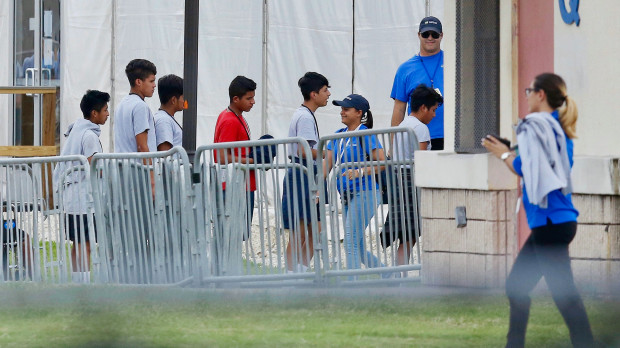WASHINGTON: Separated from his father at the US-Mexico border last year, the little boy, about 7 or 8, was under the delusion that his dad had been killed. And he thought he was next.
Other children believed their parents had abandoned them. And some suffered physical symptoms because of their mental trauma, clinicians reported to investigators with a government watchdog.
“You get a lot of ‘my chest hurts’, even though everything is fine” medically, a clinician told investigators. The children would describe emotional symptoms: “Every heartbeat hurts”, or “I can’t feel my heart”.
Children separated during the Trump administration’s “zero tolerance policy” last year, many already distressed in their home countries or by their journey, showed more fear, feelings of abandonment and post-traumatic stress symptoms than children who were not separated, according to a report September 4 from the inspector general’s office in the Department of Health and Human Services.
The chaotic reunification process only added to their ordeal.
Some cried inconsolably. Some were angry and confused. “Other children expressed feelings of fear or guilt and became concerned for their parents’ welfare,” according to the report.
The child who believed his father was killed “ultimately required emergency psychiatric care to address his mental health distress”, a program director told investigators.
Child psychiatrist Dr Gilbert Kliman, who interviewed dozens of migrant children in shelters after zero-tolerance took effect, told the PBS series “Frontline” and the Associated Press that the kids can move on with their lives after reunifying with parents but may never get over it.
As children they have night terrors, separation anxiety, trouble concentrating. As they become adults, they face greater risks of mental and physical challenges, from depression to cancer.
Among the separated children, he foresees “an epidemic of physical, psychosomatic health problems that are costly to society as well as to the individual child grown up”. “I call it a vast, cruel experiment on the backs of children.”
The AP obtained a copy of the report in advance of the official release, the first substantial accounting by a government agency on how family separation under the Trump policy has affected the mental health of children. It was based on interviews with about 100 mental health clinicians who had regular interactions with children but did not directly address the quality of the care the children did receive.
“Facilities reported that addressing the needs of separated children was particularly challenging, because these children exhibited more fear, feelings of abandonment and post-traumatic stress than children who were not separated,” said Deputy Inspector General Ann Maxwell. “Separated children are also younger than the teenagers facilities were used to caring for.”
A second report September 4 by the watchdog found that thousands of childcare workers were given direct access to migrant children before completing required background and fingerprint checks.
The report covers a period last year when facilities were overwhelmed by the policy under which at least 2,500 children were separated from their parents. They stayed behind in border custody while their parents were taken to federal court for criminal proceedings. Children held longer than 72 hours were transferred into HHS custody and placed in shelters that have traditionally cared for children who crossed the border alone.
Migrant children stay in the shelters, run by government-funded organizations, until released to a sponsor, usually a parent or close relative.
The watchdog said the longer children were in custody, the more their mental health deteriorated, and it recommended minimizing that time. It also suggested creating better mental health care options and hiring more trained staff.
The Administration for Children and Families, the HHS division that manages children, concurred with the recommendations and said it had already begun implementing them, including hiring a board-certified child, adolescent and adult psychiatrist to serve as a mental health team leader.
Department Assistant Secretary Lynn Johnson said in a letter to the watchdog that the average length of stay is much shorter now and noted the report was not a clinical review of treatment.
She wrote that “significant factors” beyond the agency’s control contributed to “the issues identified in the report”. Those included a surge in children at the border, the children’s unique mental health needs and a shortage of qualified bilingual clinicians, especially in rural areas.
She said that efforts were made to bring in more medical health professionals, but “adverse media coverage and negative public perception… have hampered efforts to expand”.
After a federal judge ordered the children reunified with their parents, guidance on how to do it kept changing and that led to further anxiety and distress, according to the report.
In one case, a child was moved from a Florida facility to Texas to be reunited with her father. After the child made several trips to the detention center, she was returned to the Florida facility “in shambles”, without ever seeing him.
Investigators visited 45 facilities in 10 states during August and September of 2018, interviewing about mental health clinicians.
During the interviews, there were almost 9,000 children in shelters; nearly 85 per cent were 13-17 in age, 13 per cent were 6-12 and 2 percent were infants to age 5.
At a minimum, each child in government custody is to receive one counselling session per week, plus two group sessions to discuss issues.
But the report found that mental health staff were overwhelmed. Usually there is one mental health clinician for 12 children, but during the period investigators studied, there were more than 25 children for one clinician.
A second Office of Inspector General report found 31 of the 45 facilities reviewed had hired case managers who did not meet Office of Refugee Resettlement requirements, including many without the required education. In addition, the review found 28 of the 45 facilities didn’t have enough mental health workers.
That meant some children didn’t receive proper treatment, the report found. And some children who suffered more severe illnesses – self-harming, suicidal behavior or actual suicide attempts – were not transferred quickly enough to residential treatment centers.
During a time when sponsors had to be fingerprinted, children were held in facilities for as long as 93 days. The fingerprints were sent to US Immigration and Customs Enforcement, and some people in the United States illegally were arrested. Advocates said many potential sponsors feared coming to get the children while the policy was in effect.
After it was scrapped in March, the average stay dropped to 58 days and was 48 days in April.
The report also addressed the question of whether children were being given psychotropic medications after media reports described the practice. The report found the instances were minimal; about 300 children overall between May and July of 2018 were prescribed antidepressants. Staff described some concerns that dosages or types of medication may not have been right.
In the second report, only four of the 45 shelters reviewed by the US Health and Human Services inspector general met all staff screening requirements.
Sen. Rob Portman, R-Ohio, said children deserve compassionate care.
“Grantees and contractors that fail to ensure their employees are checked appropriately should not be allowed to care for these children,” said Portman.
Federal investigators also found some shelters relying on employees to report their own criminal histories. A background check found one employee – who “self-certified” that she had no history for crimes involving child abuse – had a third-degree child neglect felony on her record.
HHS Assistant Secretary Johnson said the agency has rescinded background check waivers at non-emergency shelters and is committed to ensuring care providers in residential settings have completed all screenings before working with children. AP







